|
|
The Icon of our Lord Jesus Christ Not-made-with-hands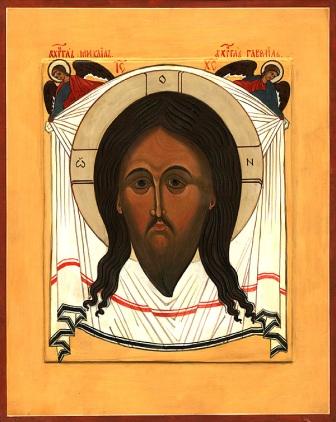 In the time that our Lord was preaching the Gospel and healing every disease and every infirmity among the people, there was in the city of Edessa, on the banks of the Euphrates, a certain Prince Avgar, who was riddled with leprosy. He heard of Christ, the Healer of every pain and sickness, and sent a portrait-painter, Ananias, to Palestine with a letter to Christ, in which he begged the Lord to come to Edessa and heal him of his leprosy. In the event of the Lord"s not being able to come, the prince commanded Ananias to paint His likeness and bring it, believing that the portrait would heal him. The Lord replied that he could not come, as the time of His Passion was at hand, and He took a napkin and wiped His face, leaving a perfect reproduction of His most pure face on the napkin. The Lord gave this napkin to Ananias, with a message to say that the prince would be healed by it, but not entirely, and He would therefore send him later an envoy who would rid him of the remainder of the disease. Receiving the napkin, Avgar kissed it and the leprosy fell from his body, with just a little remaining on his face. Later, the Apostle Thaddaeus, preaching the Gospel, came to Avgar, healed him secretly and baptised him. Then the prince smashed the idols that stood at the city"s gateway and placed the napkin with the face of Christ above the entrance, stuck onto wood, surrounded with a gold frame and ornamented with pearls. The prince also wrote above the icon on the gateway: "O Christ our God, no-one who hopes in Thee will be put to shame". Later, one of Avgar"s great-grandsons restored idolatry, and the Bishop of Edessa came by night and walled-in the icon above the gateway. Centuries passed. In the time of the Emperor Justinian, the Persian King, Chozroes, attacked Edessa, and the city was in great affliction. The Bishop of Edessa, Eulabius, had a vision of the most holy Mother of God, who revealed to him the secret of the icon, walledin and forgotten. The icon was found, and by its power the Persian army was defeated. In the time that our Lord was preaching the Gospel and healing every disease and every infirmity among the people, there was in the city of Edessa, on the banks of the Euphrates, a certain Prince Avgar, who was riddled with leprosy. He heard of Christ, the Healer of every pain and sickness, and sent a portrait-painter, Ananias, to Palestine with a letter to Christ, in which he begged the Lord to come to Edessa and heal him of his leprosy. In the event of the Lord"s not being able to come, the prince commanded Ananias to paint His likeness and bring it, believing that the portrait would heal him. The Lord replied that he could not come, as the time of His Passion was at hand, and He took a napkin and wiped His face, leaving a perfect reproduction of His most pure face on the napkin. The Lord gave this napkin to Ananias, with a message to say that the prince would be healed by it, but not entirely, and He would therefore send him later an envoy who would rid him of the remainder of the disease. Receiving the napkin, Avgar kissed it and the leprosy fell from his body, with just a little remaining on his face. Later, the Apostle Thaddaeus, preaching the Gospel, came to Avgar, healed him secretly and baptised him. Then the prince smashed the idols that stood at the city"s gateway and placed the napkin with the face of Christ above the entrance, stuck onto wood, surrounded with a gold frame and ornamented with pearls. The prince also wrote above the icon on the gateway: "O Christ our God, no-one who hopes in Thee will be put to shame". Later, one of Avgar"s great-grandsons restored idolatry, and the Bishop of Edessa came by night and walled-in the icon above the gateway. Centuries passed. In the time of the Emperor Justinian, the Persian King, Chozroes, attacked Edessa, and the city was in great affliction. The Bishop of Edessa, Eulabius, had a vision of the most holy Mother of God, who revealed to him the secret of the icon, walledin and forgotten. The icon was found, and by its power the Persian army was defeated.The Holy Martyr Diomedes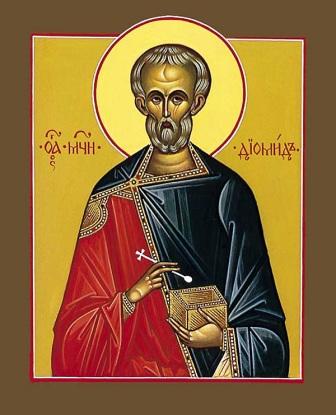 A doctor from Tarsus of eminent parents, he taught the people the Christian faith as he healed them. The Emperor Diocletian ordered that he be beheaded in Nicaea in 298. Those who beheaded him and took his head to the Emperor were blinded, and when they restored the head to his body, with prayer, they were healed. A doctor from Tarsus of eminent parents, he taught the people the Christian faith as he healed them. The Emperor Diocletian ordered that he be beheaded in Nicaea in 298. Those who beheaded him and took his head to the Emperor were blinded, and when they restored the head to his body, with prayer, they were healed.Our Holy Father Joachim of Osogovsk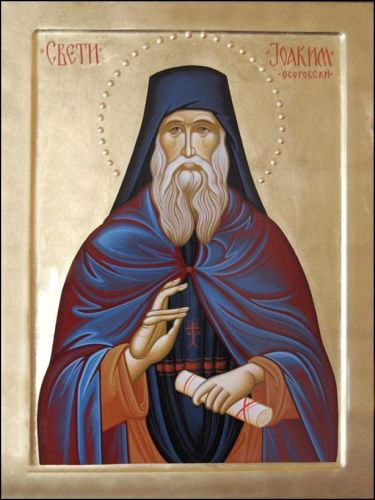 He lived the ascetic life in the second half of the eleventh century on the mountain of Osogovsk, in a cave in a place called Sarandopor. In that place another ascetic, Theodore of the Sheepfield, to whom St Joachim appeared in a dream, built a church. Many miracles have been performed throughout the centuries over the relics of St Joachim, and are to this day. He lived the ascetic life in the second half of the eleventh century on the mountain of Osogovsk, in a cave in a place called Sarandopor. In that place another ascetic, Theodore of the Sheepfield, to whom St Joachim appeared in a dream, built a church. Many miracles have been performed throughout the centuries over the relics of St Joachim, and are to this day.The Holy Martyr StamatiusHe was a villager, born in Volos in Thessaly. When some inhuman Aga collected the imperial tax from the people and left them in a terrible plight, Stamatius went to Constantinople with several companions, to complain to the Vizier. The Sultan"s nobles bore Stamatius a grudge for his stern accusation, and they arrested him. They first tried to convert him to Islam by flattery, promising him riches, glory and honour. Then the Turks tortured him and finally beheaded him in front of St Sophia"s, in 1680. Thus this soldier of Christ was crowned with the wreath of martyrdom.
St. Eustathius II, archbishop of Serbia (1309)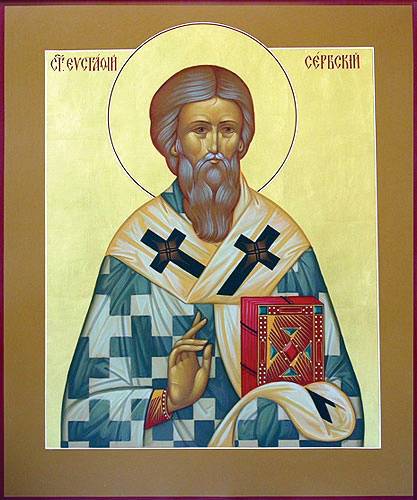 Jevstatije II (Јевстатије II) was the Archbishop of Serbs from 1292 to 1309. He is venerated as a saint, Saint Jevstatije II... Jevstatije II (Јевстатије II) was the Archbishop of Serbs from 1292 to 1309. He is venerated as a saint, Saint Jevstatije II...St. Roman the Sinaite of Djunisa, Serbia (14th c.)
St. Raphael of Banat, Serbia (17th c.) Venerable Cherimon (Chaeremon) of Egypt (4th c.). The Monk Cherimon asceticised in Egypt in the Skete wilderness-monastery, either at the end of the IV Century or the beginning years of the V Century. His name is remembered in the "Lausiaca" of Palladios and in the alphabetic Paterikon. His cave stood at a distance of 40 stadia from church and 12 stadia from a spring of water. The saint died at handicraft at more than 100 years of age. The Monk Cherimon is remembered likewise by the Monk Theodore the Studite (+ 11 November 826) within the Lenten Triodion – in the Service for Cheesefare Saturday, in the 6th Ode of the Matins canon. The Monk Cherimon asceticised in Egypt in the Skete wilderness-monastery, either at the end of the IV Century or the beginning years of the V Century. His name is remembered in the "Lausiaca" of Palladios and in the alphabetic Paterikon. His cave stood at a distance of 40 stadia from church and 12 stadia from a spring of water. The saint died at handicraft at more than 100 years of age. The Monk Cherimon is remembered likewise by the Monk Theodore the Studite (+ 11 November 826) within the Lenten Triodion – in the Service for Cheesefare Saturday, in the 6th Ode of the Matins canon.St. Timothy of Chalcedon, archbishop, founder of the monastery of Pendeli 33 Martyrs of Palestine
Translation of the relics of Martyrs Seraphim, Dorotheus, James, Demetrius, Basil and Sarantis of MegarisVenerable Nilus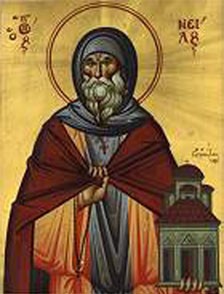 Brother of Emperor Theodore Laskaris, who rebuilt the monastery of the Mother of God at Epirus Brother of Emperor Theodore Laskaris, who rebuilt the monastery of the Mother of God at EpirusMartyr Alcibiades
New Martyr Nicodemus of Meteora (1551)The MonkMartyr Nikodemos of Meteoreia asceticised in Thessaly, and suffered in the year 1551.
Great New Martyr Apostolos (1686)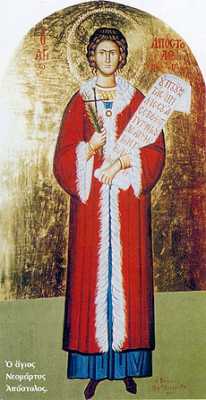 Of the town of St. Laurence, martyred in Constantinople (1686) Of the town of St. Laurence, martyred in Constantinople (1686)New Martyr Stamatius of Volos, Thessaly (1680)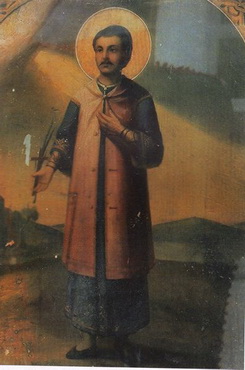 The Martyr Stamatios was a native of the city of Boleia (Thessaly). They slandered him as having accepted Islam, but he bravely confessed himself a Christian and was beheaded by the sword at Constantinople in 1680. The Martyr Stamatios was a native of the city of Boleia (Thessaly). They slandered him as having accepted Islam, but he bravely confessed himself a Christian and was beheaded by the sword at Constantinople in 1680.Holy Martyr Kristepore Guruli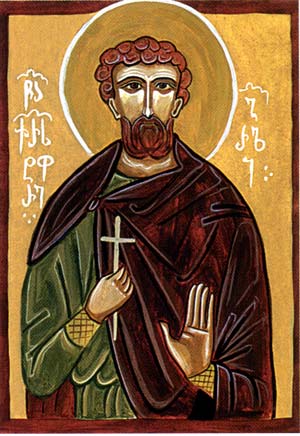 The Martyr It is commonly believed that St. Christopher Guruli was martyred, but little information exists about him to prove this. Christopher’s name has been preserved in the nation’s memory, and he is commemorated in the Church calendar... The Martyr It is commonly believed that St. Christopher Guruli was martyred, but little information exists about him to prove this. Christopher’s name has been preserved in the nation’s memory, and he is commemorated in the Church calendar... |